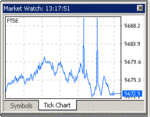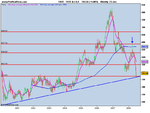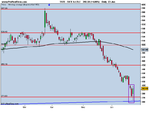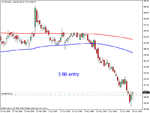Stuart,
Good question, but one that doesn't really have a right or wrong answer.
We can delve a little deeper into why equities' boys prefer to use close prices rather than high's or low's though - because the majority of liquidity in equities markets is over an exchange, it can be very difficult to move a position outside of these hours (particularly for London only listed comapnies, or FTSE 250 stocks, etc...). Consequently, it can be argued that "close" prices hold more weight in equity markets than they do in, say, FX markets; come the last hour of equity exchange trading, many traders will be reviewing the price of the stock and their position in it. A stock on a bullish run, for example, may see a drop in price towards the end of the session as profits are taken from long positions - an indication that the traders are not prepared to hold on to their illiquid position after market hours (there may be earnings due for a competitor, for example). The close price represents the balance between bulls and bears that are willing to accept the out-of-hours risk; It is the illiquidity of equities markets after exchange traded hours that make close prices so much more significant.
Consider this in comparison with OTC markets, such as Bond or FX - due to the change in trading hours across the globe, it will usually be possible to unwind a position at pretty short notice any time of the day. Come the end of the London session, a currency trader can always telephone his mate over in the US and ask him to keep an eye on his position for him, granting him the right to close it if some US economic figure comes in below expectations, or whatever. Added to that the difficulty of getting everyone to agree on the "open" and "close" hours themselves, and it becomes tricky.
One can make use of the closed prices in OTC markets though; For example, by setting your charts to run on 8hr timeframes, with the open and closing times coinciding with the activity across the continents, some qualitative information can be gained. It is possible to see, for example, if a Support level in EUR/JPY was tested and held in London and the US (i.e. price closed above support for both sessions), but re-tested and failed during the asian market hours (price closing below said level of support).
Good question, but one that doesn't really have a right or wrong answer.
We can delve a little deeper into why equities' boys prefer to use close prices rather than high's or low's though - because the majority of liquidity in equities markets is over an exchange, it can be very difficult to move a position outside of these hours (particularly for London only listed comapnies, or FTSE 250 stocks, etc...). Consequently, it can be argued that "close" prices hold more weight in equity markets than they do in, say, FX markets; come the last hour of equity exchange trading, many traders will be reviewing the price of the stock and their position in it. A stock on a bullish run, for example, may see a drop in price towards the end of the session as profits are taken from long positions - an indication that the traders are not prepared to hold on to their illiquid position after market hours (there may be earnings due for a competitor, for example). The close price represents the balance between bulls and bears that are willing to accept the out-of-hours risk; It is the illiquidity of equities markets after exchange traded hours that make close prices so much more significant.
Consider this in comparison with OTC markets, such as Bond or FX - due to the change in trading hours across the globe, it will usually be possible to unwind a position at pretty short notice any time of the day. Come the end of the London session, a currency trader can always telephone his mate over in the US and ask him to keep an eye on his position for him, granting him the right to close it if some US economic figure comes in below expectations, or whatever. Added to that the difficulty of getting everyone to agree on the "open" and "close" hours themselves, and it becomes tricky.
One can make use of the closed prices in OTC markets though; For example, by setting your charts to run on 8hr timeframes, with the open and closing times coinciding with the activity across the continents, some qualitative information can be gained. It is possible to see, for example, if a Support level in EUR/JPY was tested and held in London and the US (i.e. price closed above support for both sessions), but re-tested and failed during the asian market hours (price closing below said level of support).






